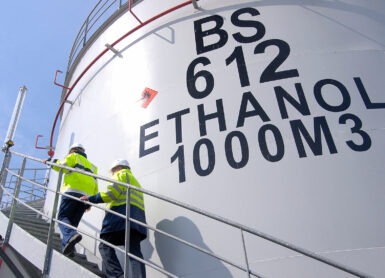
Chemicals play a major role in determining the consequences of an accidental loss of containment scenario.
First, depending on the state of aggregation of the chemical substance at its process conditions, its accidental release may lead to different possible phenomena. In process safety, the typical states of aggregation are solid, liquid, gas, pressurized liquefied gas and refrigerated liquefied gas (which is the physical state for cryogenic substances).
Examples of gases at ambient conditions are natural gas (NG), hydrogen and carbon dioxide. However, natural gas can also occur in a liquid state when cooled down to around -162°C, commonly known as liquefied natural gas (LNG). LNG is typically used for large-scale storage and sea transport. Hydrogen can also occur as a pressurized liquefied gas by compression and refrigeration to temperatures below -240°C. Hydrogen is more commonly used in the gaseous state, but it is also stored and transported as a liquid. Liquid hydrogen can also be used as rocket fuel. Examples of typical liquids used in the chemical industry are petrol and acrylonitrile.
The direct ignition of a continuous release of natural gas (a gas at ambient conditions) leads to a jet fire, whereas those same scenario conditions for a release of acrylonitrile (a liquid at ambient conditions) lead to a pool fire. On the other hand, the direct ignition of an instantaneous release of LPG (Pressurised Liquefied Propane) leads to a BLEVE, whereas the same scenario for natural gas leads to a gas fireball. For more examples of which phenomena to expect upon the release of a chemical with different physical states, please refer to the blog post “Fire and explosion hazards: What to expect if there is a leak”.
The boiling point of liquids is usually above ambient temperature. Depending on the temperature and volatility of the substance, evaporation from the liquids can occur. Above the critical temperature, a gas can no longer be compressed into a liquid no matter how high the pressure applied is. This explains why natural gas, which has a critical temperature of -83°C, cannot be liquefied by means of compression while it remains at ambient temperature.
That is the reason why the physical state of the chemical, as well as its typical properties (think of Lower Flammability Limit or heat of combustion), are extremely important when evaluating a loss of containment scenario. The physical state will determine the type of phenomena we expect to happen, and the chemical’s properties will determine the severity these scenarios may have on the surrounding population and the environment.
The DIPRR database
The state of aggregation of the chemical of interest, and its other properties, will greatly impact the consequences of a loss of containment scenario.
That is why it is so important that consequence and risk modelling software such as Gexcon’s safety tools EFFECTS and RISKCURVES are equipped with an extensive chemical database that includes all those properties for a large range of chemical substances. This will ensure that consequence modelling calculations are performed accurately, all relevant phenomena are properly determined, and the severity of the effects are correctly assessed.
EFFECTS and RISKCURVES use the DIPPR chemical database, which stands for Design Institute for Physical Properties. The DIPPR chemical database was originally developed by the American Institute of Chemical Engineers (AIChE), which is recognized as the world’s premier source of critically evaluated thermo-physical properties and contains over 2000 chemical substances. The properties presented in DIPPR have been subject to an extensive evaluation and validation methodology, which provides constant insight into the quality of the database, as well as the relevant guidance for needed experimental work to address data gaps and improve data.
The DIPPR chemical database is available within EFFECTS and RISKCURVES and classifies the chemical’s properties into constant, temperature-dependent, toxic and threshold concentrations.
Constant properties
Examples of constant properties are molecular weight, critical temperature, and normal boiling point. Constant properties remain the same and are not temperature-dependent. While the critical temperature determines the state of aggregation evaluations, the molar weight is obviously highly relevant too. The latter is used extensively to translate volume-based concentrations (such as vol% or ppm) to mass-based concentrations (such as mg/m3), which can be done on the fly in EFFECTS and RISKCURVES. For flammable materials, properties like Lower Flammability Limit and heat of combustion are of great importance to derive consequences of fire or explosion events.

Temperature-dependent properties
Examples of temperature-dependent properties are liquid density, the heat of vaporization, and liquid vapour pressure.
These properties are dependent on the temperature. If you click on a temperature-dependent property, DIPPR will illustrate the corresponding temperature-dependent graph, the formula used for its calculation, as well as the corresponding function constants (which are chemical-dependent). The liquid vapour pressure is of extreme importance because it describes storage pressures and determines the evaporation flux of a liquid pool depending on its temperature. Viscosity may play an important role in pipe outflow calculations as it influences pressure loss. All chemicals in the DIPPR chemical database include a non-ideal gas behaviour by means of the second virial coefficient, which describes the compressibility factor of the material.

Threshold concentrations
Threshold concentration values are shown, when available, for all chemicals in the database. Some examples of threshold concentrations are AEGLs (Acute Exposure Guideline Levels), ERPGs (Emergency Response Planning Guidelines), IDLH (Immediately Dangerous to Life or Health), and PAC values (relating to occupational acceptance guidelines).
These types of concentration thresholds are commonly used in dispersion models to evaluate up to which distance we can have an “unsafe” situation. Unfortunately, there is no international consensus on which levels are to be regarded as unsafe; therefore, the dispersion models in EFFECTS also allow the definition of user-defined concentration levels.

Toxic properties
Toxic properties are shown for those chemicals where toxic Probits are available. These Toxic Probits define how a concentration should be translated into an accumulated dosage and corresponding fraction of lethality due to inhalation. Toxic properties consist of the constants A, B and N used to define the chemical’s toxic Probit function. The toxic Probit function (Pr) measures probability to assess damage to people due to exposure to a toxic concentration over time. The Probit function can be calculated as follows:

The toxic dose (D) can be expressed as shown below, where C is concentration and t is time:


All the properties in the DIPPR chemical database are thoroughly validated and internationally accepted by major companies involved in the DIPPR collaboration before publication. Only the values officially published by the Dutch authorities are provided for the toxic Probit constants. That means that not all toxic chemicals in the database might have toxic properties, whereas other countries may consider other values because there is no international consensus about toxicity.
There might be external literature that provides alternative toxic Probit constants. The user can add them manually to their user-defined chemical database (see next chapter for more information). Additionally, EFFECTS has a toxic damage model called “Toxic damage model – conversion from animal experiments” that can be used to translate from animal experiments to toxic Probit constants.
Mixtures
The DIPPR chemical database in EFFECTS and RISKCURVES provides the user with some typical example mixtures such as Brent Crude, Diesel or Naphta. However, because even Gasoline differs in composition depending on the geographic region, the user might want to create a different mixture with different compositions and/or other components.
That is why EFFECTS and RISKCURVES also allow the user to create user-defined mixtures. The mixture properties will be based on mixing rules such as Ideal Mixing, Le Chatelier or Kendall-Monroe (among others). The main limitations of creating mixtures in EFFECTS and RISKCURVES is that:
- Binary interactions, chemical reactions, absorption effects and maximum solubility are not taken into account.
- Mixture properties are based on a quadric equation of state, which includes compressibility effects based on the second virial coefficient.
The user-defined chemical database
EFFECTS and RISKCURVES allow the definition of a user-defined chemical database. This is a very useful feature that allows the user to modify any property from the DIPPR database and add additional data such as toxic Probit constants, or add a specific threshold concentration value, etc.
This functionality is very helpful to ensure traceability. Although properties can be added or changed in the user-defined chemical database, the user can always refer to the original unchanged DIPPR chemical database.
How to use DIPRR in EFFECTS and RISKCURVES
Would you like to know more about the functionality offered by the DIPPR chemical database, which is implemented within the consequence and risk modelling tools EFFECTS and RISKCURVES? Watch the 9-minute video below for an introduction on how to use the DIPPR chemical database in EFFECTS and RISKCURVES. The video includes topics such as: how to create a mixture, how to create a user-defined chemical database, how to filter chemicals, etc.
As you can see from the video, using the chemical database in EFFECTS and RISKCURVES is very straightforward and user-friendly.
Free viewing demo version of EFFECTS available for download
Do you want to start making the world a safer place?
Get started by downloading the free EFFECTS viewing demo, available for download via the button below.
Do you like what you read?
Get the latest trends in the field of process safety management straight to your inbox, and enhance your skills through knowledge sharing from industry experts.


